Get Rid of Rats (3 Lethal Ways!)
Rats are a type of rodent but not your regular kind of pest. They are cunning and intelligent and can damage your home and spread disease.
You need to get rid of the rats quickly before they establish themselves too well in your house or business premises.
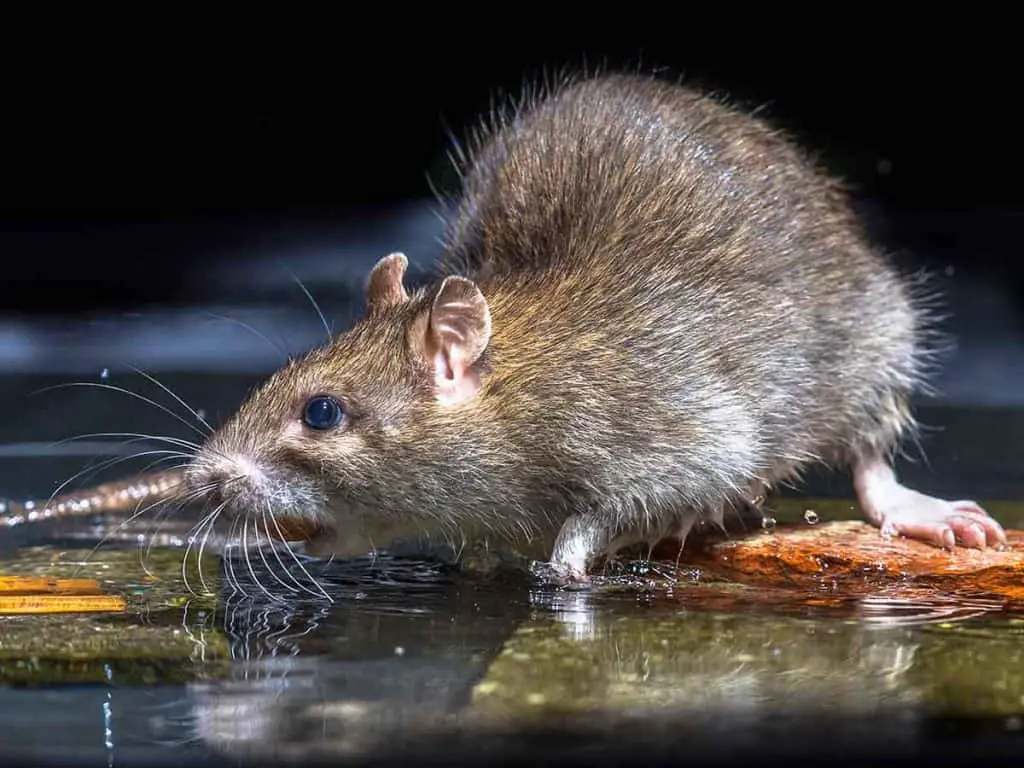
How Do You Know if You Have Rats in Your House?
Rats are nocturnal creatures that shy away from humans, but detecting the presence of a rat infestation is not difficult.
These are typical signs of rats in your house:
- Scratching, scrabbling, and squeaking noises as they move around hidden spaces.
- Chew marks on the wooden walls, cabinets, or food containers.
- Pellet-shaped droppings approximately ½ inch long.
- Grayish grease marks along baseboards and cabinet walls.
- Rodent hair around corners and gaps in the wall.
- Foul odor near and around places you suspect rats are hiding.
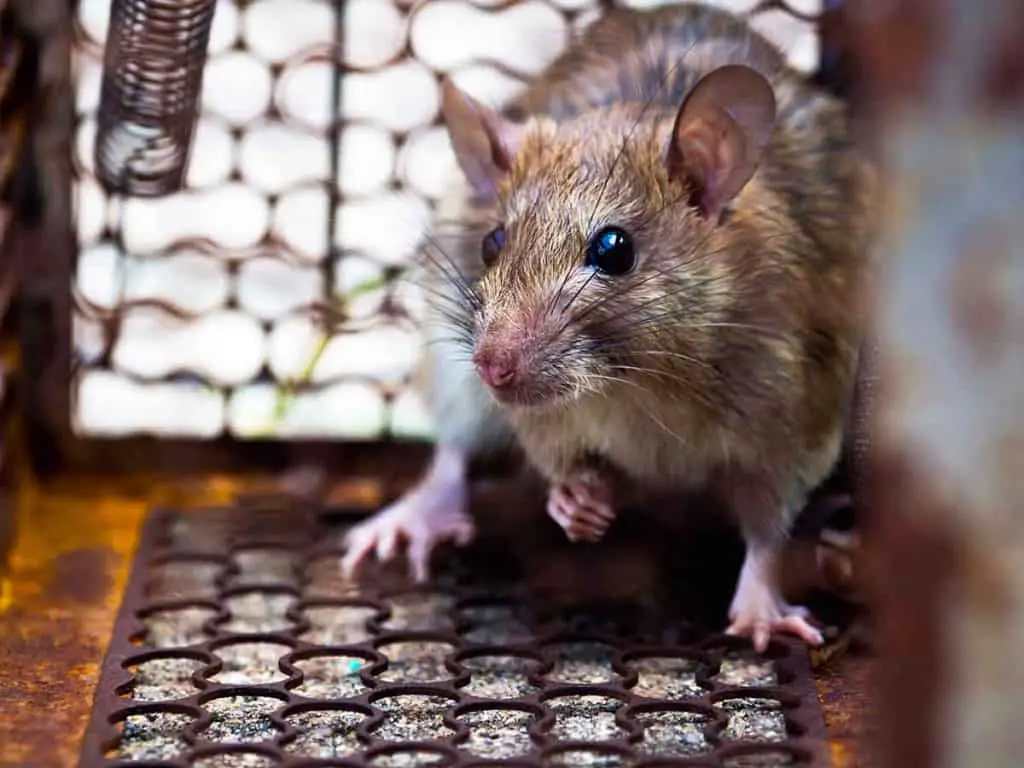
THE 3 BEST WAYS TO GET RID OF RATS
You will not find natural scenting methods in this post because they do not work with rats. The notion that scents are effective in driving away rats is a misconception.
Take cloves, for instance.
It is impractical to spread cloves along every inch of your house. When stumbling upon a repellent or obstruction along their path, they simply go around it.
Mind you, these foods lose their pungent smell over time, and you may not see them again because the rats ate them.
Time is precious; you need to get rid of rats quickly and effectively.
Let’s get down to business.
1. Poison Bait in a Bait Station
The premise is to let the rats enjoy their last meals before dying elsewhere when the poison takes effect and kills them.
Mix equal parts granulated sugar and baking soda in a bowl, and place it in the bait station; mix them well. You may add other sweet treats such as chocolate chips if you wish, but sugar will suffice.
Wear disposable gloves while mixing the bait and setting up the station. You don’t want to stain the station with sweet scents, so the rats can only smell one clear target – the poison bait inside.
You can buy a bait station (see recommended products below) or make one yourself using a box with two cut-out holes (one at each end) for the rats to enter and exit.
The bait station ensures only the rodents can access the poison bait inside, making the setup safe to deploy around your pets and children.
However, as the rat could die anywhere, including in the ceiling or walls, removing the dead carcass may prove difficult, and the need only becomes apparent when it starts to smell.
2. Snap Trap to Kill
Rats get the label ‘pest’ for a reason – they cause severe damage to your property and transmit diseases.
They are rodents that multiply rapidly when left unchecked, and a colony can wreak havoc – just ask farmers who lose an entire season’s crop to a rat infestation.
For your home, a snap trap makes quick work of the rats. Buy larger-sized traps with a powerful spring and serrated jaws that grip the rat firmly and kill it instantly.
An undersized snap trap (primarily for mice) may be too light and weak to kill the rat; it may even run away with the trap still on its head.
As a simple guide, snap traps for rats should be at least twice the size of a credit card
(see recommended products below)
3. Glue Trap and Kill
You can buy glue traps for rats or make them yourself.
The advantages of a DIY glue trap for rats are the flexibility to make larger glue boards to catch more rats at once and the choice of a stronger glue that prevents escape.
For DIYers – Apply the glue on a board (can be a thick card or plywood for added weight), spread nuts or peanut butter at the center of the trap, and place it where the rats frequent.
Wear disposable gloves while setting up the trap so you don’t get glue on your hands.
After you successfully trapped the rats, you have 3 ways to kill them:
- Drown them in a bucket of water, or
- Decapitate them (quick death), or
- Suffocate them in a plastic bag – pour baking soda into a bag large enough to fit the trap, insert the trap, pour in the vinegar, and close the bag tightly so the resultant carbon dioxide (CO2) does not leak out.
4. Live Trap
Some pests are suitable for trapping and relocating, although it is a temporary solution that rarely ends well for the homeowner or the animal.
Live traps work by attracting the rat to the bait and triggering the spring that shuts the cage door.
If you fancy making a DIY live trap, watch the video below for an inexpensive, simple, but effective solution:
You have 2 options in dealing with the trapped rat:
- Drown the rat in a bucket of water,
- Releasing it into the woods, far from any residential area.
Releasing the rat anywhere near populated areas is not a sound idea. You don’t want the rat to return to your home or become your neighbor’s problem.
When you decide to kill a rat, choose a method that kills it quickly and as “painlessly” as possible.
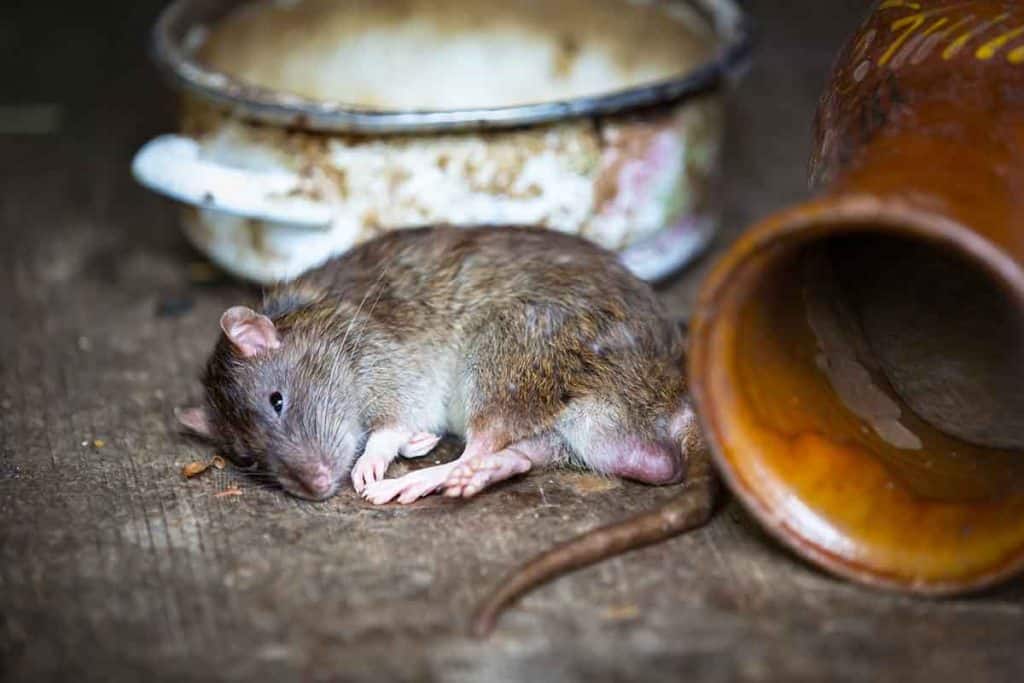
Getting Rid of Rats in the Kitchen
The kitchen is the prime spot for rats to invade for obvious reasons.
They will go after your food – raw or cooked – and potentially spread diseases when they gnaw on unopened food packaging and leave traces of feces and urine on the countertop.
Getting rid of rats in the kitchen involves doing the following:
- Step 1: Set up a poison bait – you want to kill them first before taking other remedial or preventive steps, or
- Step 1a: Set up a glue bait – trap to kill using bought or DIY trap.
- Step 2: Remove rat droppings and clean traces of urine – avoid direct contact with the skin. After that, wash your hands thoroughly.
- Step 3: Inspect the kitchen thoroughly for gaps and holes that the rats use, and plug or seal them – check the baseboards, plumbing penetrations, and ceiling.
- Step 4: Install anti-vermin window screen – metal screens are preferable.
- Step 5: Clean your kitchen rugs – regular change and clean are necessary due to food crumbs.
- Step 6: Mop the kitchen floor with a detergent – you want to do this regularly. Pets eat from the floor, and babies crawl.
- Step 7: Check and discard packaged food with bite marks – all food products in plastic bags and container packaging that are not in the refrigerator or enclosed cabinet are susceptible to rat bites.
- Step 8: Clean the countertop with a detergent – clean without a detergent after each food preparation; clean with a detergent at least once every other day.
- Step 9: Store your food in the refrigerator, cabinet, or containers with a lid – the food you place on open shelves needs to be in glass, metal, or thick-wall plastic containers.
- Step 10: Set up a rat trap under the kitchen counter as a monitoring station – this should be your on-going effort to detect the first signs of (future) rat activity.
Getting Rid of Rats in the Walls
Rats can get into the wall cavity through multiple means:
- Ceiling space.
- Vent pipes.
- Plumbing penetrations.
- Chewing through wood or plasterboard partition walls.
Some homeowners prefer to engage the exterminator’s service, but you can always give it a try yourself to save your hard-earned dollars.
Getting rid of rats in the walls will require some investigative work.
But you know which wall the rats are in from the scratching and squeaking sound, so it is not difficult as long as you go through the process methodically.
You can get rid of rats in the walls with these steps:
- Firstly, target the possible rat entry point that is the easiest for you to reach – the wall’s baseboard or any plumbing penetration.
- Place a glue trap right outside this entry point – do not use a poison trap because you don’t want the rat to die in the walls.
- If it fails to catch any rat in 2 or 3 days, plug that easy-to-reach entry point and switch focus to the ceiling space.
- Most homes will have multiple ceiling access panels. Choose the one nearest to the target wall, and place a glue trap there. Again, you don’t want to use poison bait. A dead carcass in the ceiling is hard to retrieve.
- Check the glue trap daily, remove it if you get a trapped rat, and replace it with a new trap if you think there are more of them.
- Your strategy is to seal off all possible entry points, except one, so you force the rats to use that.
Getting Rid of Rats in the Attic and Ceiling
The ceiling or attic in your home is a heaven for the rats – an ample open space that is dark, protected from predators, and free from any human activity.
Rats in the attic and ceiling are a nuisance because these places are difficult to access, but you can get rid of them nonetheless:
- Glue traps are the preferred choice (see rat control products below).
- Check the trap every 24 hours to remove trapped rats or replenish the trap with fresh bait.
- You can use a live trap if you already have one at home, but if you are buying, get glue traps.
- Kill the trapped rat by drowning it in a bucket of water or suffocation using the baking soda + vinegar = CO2 method (described in an earlier section of this post).
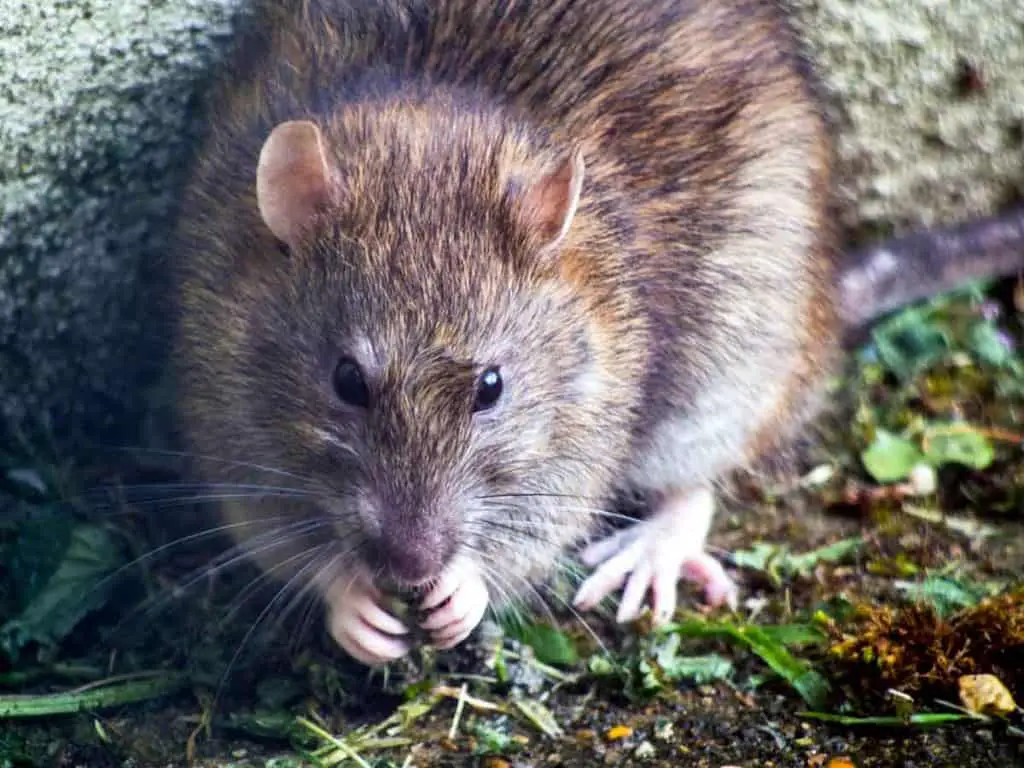
Getting Rid of Rats in the Garden
Gardeners face rat problems as much as they do indoors. With a garden full of vegetables or fruits, the rats have ready access to fresh – and premium organic – produce and find it irresistible to nest there.
What does a rat burrow look like?
The hole to a rat’s burrow typically measures 2 to 3 inches in diameter. Smooth walls on the burrow’s entrance that is clear of debris are signs of an active burrow.
Rodenticide broadcast powder, garden netting, and fencing are largely ineffective against rats. Rats can burrow and gnaw their way through most soft fence materials.
If you have a rat problem in the garden, these options are available to you:
- Place poison baits at the burrows’ entrances (see rat control products below) – let the rats die in their nests.
- Flood the burrow with an ammonia solution of 1-part ammonia and 9-part water. Plug the hole with a rag immediately and leave it for an hour or so.
- Seal the burrow entrances with soil and compact the earth around them.
- If you have a greenhouse, place glue traps along the paths that rats frequent. Check and remove trapped rats at least once a day.
Best Rat Control Products
Well-designed traps with a sturdy construction help you get rid of rats effortlessly and without unnecessary mess.
Best Rat Bait Station:
Tomcat Bait Station

The bait station allows you to kill rats without harming your pets or young children.
It is key-lockable, and you can check and replenish the bait every other day, so the rats get a continuous supply of poison that gradually decreases the colony.
What you get with this bait station:
- An enclosed station that keeps the poison bait away from your children’s or pets’ reach.
- Lockable design.
- 4x internal posts to secure the bait.
- L9.53 x W8.11 x H4.49 inches.
- Rat bait not included (see recommended bait below).
Best Rat Bait Refill:
JT Eaton 704-AP Apple Flavor Rodenticide Bait

This apple-flavored rodenticide is an attractive bait for rats.
The rat consumes the bait, which causes thirst, leaves the station searching for water to drink, and dies from the water’s reaction with the bait’s active ingredient – Diphacinone.
You can use them with the bait station recommended above, your DIY station setup, or without a bait station.
What you get with this bait refill:
- You can use them with any bait stations, including your DIY station.
- 64x one-ounce rodenticide blocks.
- Each block has a hole at the center for ease of fixing to any bait station’s posts or rods.
See the best rat poisons post for a more extensive list of rat baits. Poisons designed to kill mice generally do not act as effectively against rats.
Best Rat Snap Trap:
Made2Catch Classic Metal Rat Trap

Most plastic snap traps are too light and do not sufficiently strong spring to make a clean kill. The hassle of killing it yourself is unpleasant.
This metal trap has a robust construction and is corrosion-resistant.
Still, it is not heavy enough, given its size, so you can help it stay in place by securing it onto a wooden board with screws for added stability.
What you get with this snap trap:
- Galvanized metal trap that prevents rust and ensures multiple uses.
- Pack of 4 traps.
- Powerful spring.
- Serrated jaws along the edges of the trap base for increased grip.
- L6.6 x W3.5 x H0.9 inches.
- 4.3 ounces.
Best Rat Glue Trap:
CatchMaster Baited Rat Glue Trap

These glue traps are pre-baited, so you do not need to place additional baits.
Wear disposable gloves when opening the packaging and placing the trap to avoid accidental contact with the glue. However, you can use vegetable oil to remove the glue if it gets onto your hands.
Place the traps along the rats’ travel path for quicker results. Although you can use the trap outside your house, doing so may end up trapping other animals instead.
Do not leave the traps unchecked for longer than a day, as you do not want other rats to stumble upon a trapped rat.
What you get with this glue trap:
- Pre-baited, so setting up the trap is effortless.
- A strong and long-lasting glue – up to several months in non-dusty conditions.
- Non-toxic.
- For indoor and outdoor use; it also works in damp locations.
- L10 x W5 inches.
- Choice of 6, 8, 10, or 12 glue trap packs.
Best Rat Live Trap:
Kensizer Live Cage Trap for Rats

The Kensizer live trap is appropriately-sized for rats, and its excellent build quality ensures it traps effectively and securely.
Set up the trap in the evening so the bait remains fresh for the rats that become active at night.
You may need to wait a couple of nights for results as the rat warms up to the cage’s presence before going for the bait.
What you get with this live trap:
- Aluminum cage.
- Sturdy construction that prevents escape.
- A more sensitive pedal trigger.
- Traps rats and other mid-sized rodents.
- L12.5 x W6.5 x H5.0 inches.
What is the Difference Between Rats and Mice?
The short answer:
Mice have triangular snouts with large, floppy ears. Their body may be white, brown, or gray, and they have long, hairy tails. Rats differ subtly in these regards – blunter snouts, smaller ears, dark gray or black coats, and hairless and scaly tails. Size-wise, mice typically measure 6 to 8 inches in total length, while rats can grow to be as long as 15 inches or more.
And the simple answer you need to know:
Rats are larger and heavier than mice, and you need to use appropriately-sized traps for your rodent problem.
If you know of their presence in your home but did not spot them in action, check for grease marks on the walls along their path (rats leave these marks) or the size of the gap or hole they pass through.

How Are Rats Harmful to Humans?
Rats can transmit diseases to humans through:
- Direct handling of the rodents.
- Contact with rat feces, urine, saliva, or bites.
- Consumption of rat-contaminated food or food prepared on surfaces that contacted with rats.
- Indirect transmission via fleas, mites, or fleas that fed on infected rats.
Small to mid-sized rodents such as rats and mice spread over 35 diseases, according to the Centers for Disease Control and Prevention (CDC).
The diseases that rats can spread to humans and pet include:
- Hantavirus Pulmonary Syndrome (HPS) – spreads through rat urine and droppings (source).
- Lymphocytic choriomeningitis (LCMV) – spreads through the bite of infected rats and contact with rat saliva.
- Leptospirosis – spreads through rat urine-contaminated food or water.
- Typhus – spreads through fleas that bit infected rats.
Understanding how diseases spread from rats to humans informs you that storing your food securely in the kitchen is crucial.
How do you protect food from rats?
Proper food storage to prevent rats from getting to them include:
- Store all food in glass or metal containers with solid lids.
- Keep perishable foods in the refrigerator.
- Do not store food in plastic bags or thin-wall disposable plastic containers if you place them on the kitchen counter or open shelves.
- If you know you have rats in the house, getting rid of them should include discarding food products with broken packaging. Inspect thoroughly.
How Quickly Do Rats Multiply?
You should always deal with a rat infestation promptly as they are efficient multipliers.
Rats reach sexual maturity within 5 weeks, and they breed year-round. Their gestation period lasts 3 weeks, and a female rat can typically birth between 5 to 10 pups in a year. At this rate, a few rats can soon grow into a colony of hundreds within one year.
When Are Rats Most Active?
Rats are nocturnal and most active at night. They come out of their nests searching for food between dusk and dawn when there is no human activity. However, hungry rats will forage for food during the day.
Set up your trap in the evening, so the bait remains fresh when the rat finds it.
You may have to wait more than a night before catching one as they are careful and need time to warm up to the bait, but an alluring bait in an effective trap should yield results the first night.
Will Cats Kill Rats?
All cats, big or small, are predatory and will kill for food. Yet, they are also intelligent hunters that size up their prey before attacking because they want to avoid injuring themselves.
Domesticated cats will toy with and kill small mice but avoid rats, which are larger and pound-for-pound a worthy adversary. Your house cat will not kill rats. However, an adult male cat is useful to have around in your home as it helps chase rats away.
Will Dogs Kill Rats?
When you need a faithful companion that is equally helpful in rat control, the dog is your friend.
Dogs are an excellent natural pest control against rats and mice. Humans have bred and trained dogs to hunt and kill rats in the farms for hundreds of years. They will instinctively chase down and kill rats, although not all dog species are suitable for the job.
What Dog Breeds Kill Rats?
If you have a farm or large yard and a rat problem to control, getting a dog (or dogs) is an excellent idea – but only specific dog species with the right temperament and physical traits.
These dog breeds kill rats:
- The Terriers, such as the Jack Russel, Border, Lakeland, and Rat Terrier.
- Dachshunds.
- German Pinschers.
- Affenpinschers.
If you use dogs as ratters, you must train them to kill but not eat the rat. The rat could be carrying diseases.
When Should You Call an Exterminator for Rats?
Most homeowners do not want to seek an exterminator’s expensive service, at least not until they have exhausted DIY solutions to get rid of the problem.
A rat infestation can quickly turn into a problem when they start gnawing on electrical wires, presenting a fire hazard, and you have a large house with many clutter, which makes rat control a complicated task.
You should contact your local pest exterminator when:
- Your DIY traps fail after multiple tries and iterations,
- You notice an increasing number of rats despite your best efforts, or
- You have small children and pets in your home that makes catching or trapping rats dangerous to them.
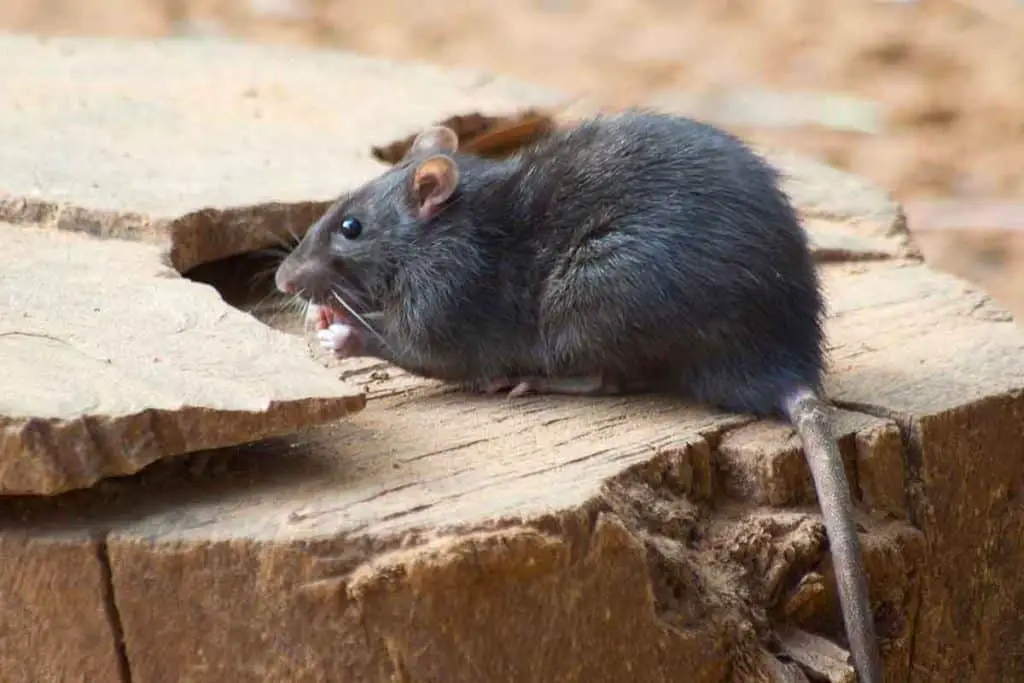
Rat Prevention Steps
Rats are intelligent and curious animals that often feed on human trash and can cause extensive damage to your home if left unchecked.
If you caught sight or signs of rats outside the house, you need to take crucial steps to ensure they don’t take hold indoors or a chance to multiply.
Effective rat prevention includes:
- Store food in glass, metal, or thick plastic containers with a lid, if you keep them outside the refrigerator and on open shelves.
- Ensure your kitchen cabinet doors can close properly and securely.
- Seal cracks in foundation or external walls (especially where the plumbing penetrates) with caulk, steel wool, or wire mesh to prevent rats from entering through them.
- Seal gaps that lead to the attic or ceiling.
- Install metal mesh screen over vents and other openings that lead to the outside of your house.
- Empty the kitchen trash can daily, even if it is not full.
- Keep the outdoor trash container closed at all times.
- Dry and clean the kitchen and food preparation surfaces after each use.
- Clean the dishes and do not leave them in the sink overnight.
- Do not eat in the bedroom; food crumbs will attract rats and other pests.
- Get rid of clutter in your home.
- Do not leave pet food overnight.
- Trim tree branches that provide rats with access to the roof.
- Use a bird feeder with a tray to prevent seeds from falling to the ground.
- Continually monitor for signs of rats.
